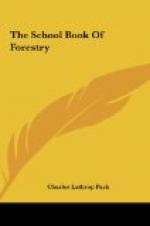Among our most useful and valuable trees are the white oak, and its close kin, the red oak, which produce a brown-colored, hard wood of remarkable durability. The white oak is the monarch of the forest, as it lives very long and is larger and stronger than the majority of its associates. The timber is used for railroad ties, furniture, and in general construction work where tough, durable lumber is needed. Many of our wooden ships have been built of oak. The white oaks often grow as high as 100 feet and attain massive dimensions. The seeds of the white oaks are light brown acorns, which are highly relished by birds and animals. Many southern farmers range their hogs in white oak forests so that the porkers can live on the acorn crop.
Beech wood is strong and tough and is used in making boxes and barrels and casks for the shipment of butter, sugar and other foods. It makes axles and shafts for water-wheels that will last for many years. The shoes worn by Dutch children are generally made of beech. The wood is red in color. The beech tree is of medium size growing to a height of about 75 feet above the ground. There is only one common variety of beech tree in this country.
Hickory trees are very popular because they produce sweet, edible nuts. The hickory wood is exceedingly strong and tough and is used wherever stout material is needed. For the spokes, wheels and bodies of buggies and wagons, for agricultural implements, for automobile wheels and for handles, hickory is unexcelled. The shafts of golf clubs as well as some types of base-ball bats are made of hickory. Most hickory trees are easy to identify on account of their shaggy bark. The nuts of the hickory, which ripen in the autumn, are sweet, delicious and much in demand.
Our native elm tree is stately, reaching a height of 100 feet and a diameter of 5 to 6 feet or more. It is one of our best shade trees. Elm wood is light brown in color and very heavy and strong. It is the best available wood for making wagon wheel hubs and is also used largely for baskets and barrels. The rims of bicycle wheels generally are made of elm.
The canoe birch is a tree which was treasured by the early Indians because it yielded bark for making canoes. Birch wood is used in making shoe lasts and pegs because of its strength and light weight, and the millions of spools on which cotton is wound are made of birch wood. School desks and church furniture, also, are made of birch. The orange-colored inner bark of the birch tree is so fine and delicate that the early settlers could use it as they would paper. No matter whether birch wood is green or dry, it will burn readily. The birch was the most useful tree of the forest to the Indians. Its bark was used not only for making their canoes, but also for building their wigwams. They even dried and ground the inner bark into a flour which they used as a food.




